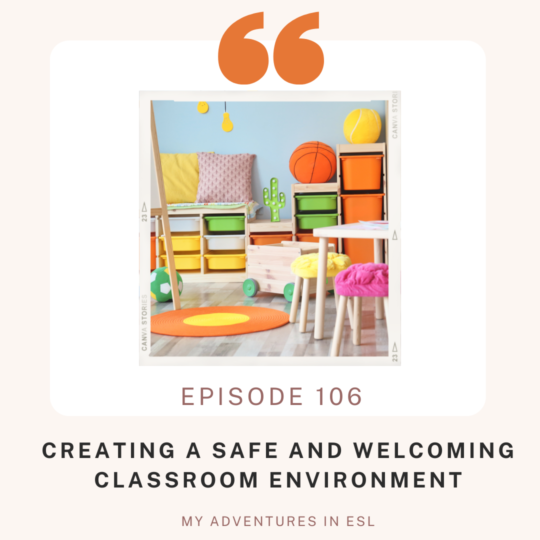
Creating a Safe & Welcoming Environment for Language Learners
While researching and learning more about how to create a learning and welcoming environment, I learned that there are major components to creating a warm and welcoming classroom environment.
Those components are physical, psychological, and emotional. We are going to start today’s episode with your reflection question. How are you currently creating a safe and welcoming environment for your Language Learners? Take a moment to reflect on this question. Think about this question and answer yourself honestly about where you stand.
Creating a warm and welcoming environment for your Language Learners is something that should be done all year. I noticed that educators focus on this a lot at the beginning of the school year, and in some cases, it falls by the wayside as the school year progresses. This can be for a lot of reasons. Some of those reasons can be that you are overwhelmed with work, grading papers, and supporting your students. This can lead to us being less intentional about creating a warm and welcoming environment.
At the beginning of the school year, we are focused on decorating our classrooms, creating seating charts, and working on our lesson plans. Creating a warm and welcoming environment should be incorporated into how we prepare for the school year.
s to how your classroom is designed to support the students’ safety and learning. Psychological is how you can create a trusting environment that encourages your students to take risks, ask and answer questions, and receive constructive feedback. Finally, emotional refers to celebrating and acknowledging class diversity, achievements, and culture.
Now that we know the three components of fostering a safe and welcoming classroom environment, let’s share some tangible strategies you can use in your classroom.
Morning Meeting/Daily Check-in: A morning meeting/daily check-in allows you to check in with your students about how they are feeling. This is also an opportunity to learn more about your
students. You can be creative with how you do your check-ins. For example, I do my check-ins as we are walking to my class each day. Morning meetings and daily check-ins set the tone and the mood for the class each day.
Openly Make Mistakes: I am a strong believer in showing my students that I am not perfect. I am human, and I make mistakes when I read and write. Sometimes these mistakes and intentional and sometimes they are not. An example of me making an intentional mistake is when I have students try to find my mistake when I am writing. This simple gesture builds trust and creates an environment that shows it is safe to make mistakes.
Respect Your Students: Respect is a two-way street. I always cringe when I hear teachers screaming and making snide comments to students. I always think to myself, “You want respect, but you are not giving the students the same courtesy.” I want to encourage all of you to respect your student’s cultures, their differences, the way they dress, and everything about them. I always try to ask myself how I would want to be treated in the scenarios that pop up in school. If I don’t want to be screamed at or embarrassed, why would I do the same to my students?
Classroom Design and Vibes: You do not have to spend a ton of money to have an effective classroom design. I have seen teachers put up dim lights, play soft music, and have traditional desks for their students. Some as simple as music playing can decrease stress and set a positive tone for the students.
Actively Participate in the Lessons: Instead of just giving the students an assignment and asking them to complete it, complete the assignment alongside them. You can model how to complete the assignment, so they are clear on the expectations. This also gives the students an opportunity to see how you (the teacher) are thinking. This can build community in your classroom and a sense of belonging because the students see that you are willing to take risks and participate in the lesson.
I have provided you with five practical strategies you can use in your classroom. I want to encourage just try one of these strategies next week in your classroom. Just take it one day at a time. Think about where you are with creating a safe and welcoming environment. Ask yourself what changes can be made so that your students feel safe and welcome.
I would love to hear more about how you are creating a safe and welcoming environment for your students. Share your ideas and strategies in our Facebook community “My Adventures in ESL” or on the blog at My Adventures in ESL. I have also referenced some great websites that show more ideas on how to create a safe and welcoming classroom for your students.
References:
https://www.wgu.edu/blog/15-tips-creating-safe-learning-environment2202.html#close
https://www.edutopia.org/blog/20-tips-create-safe-learning-environment-rebecca-alber
You can download transcript here.




